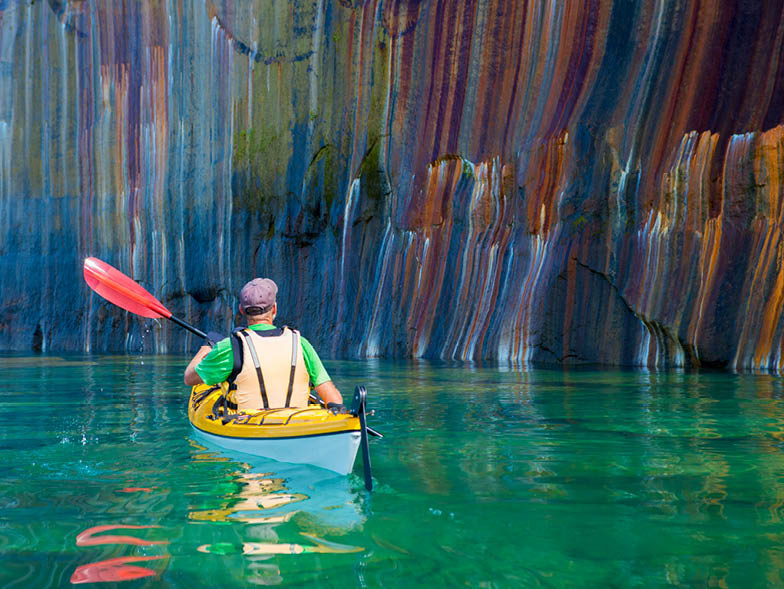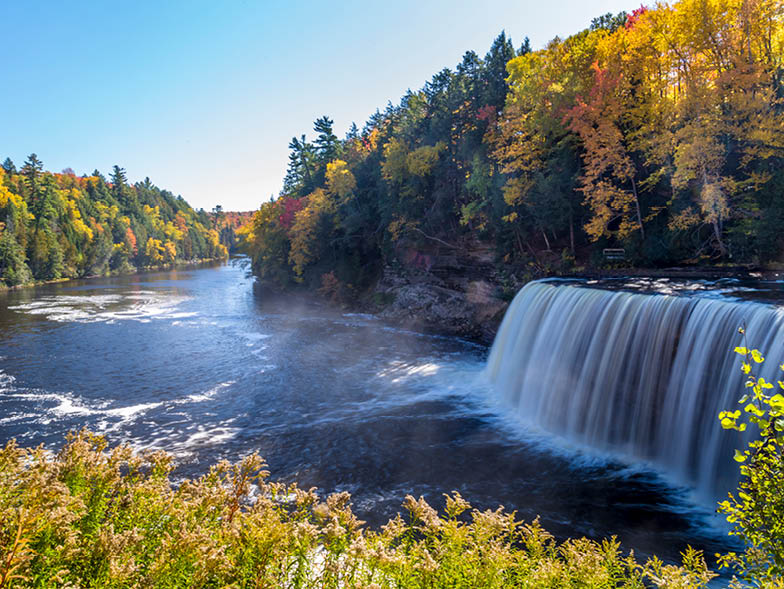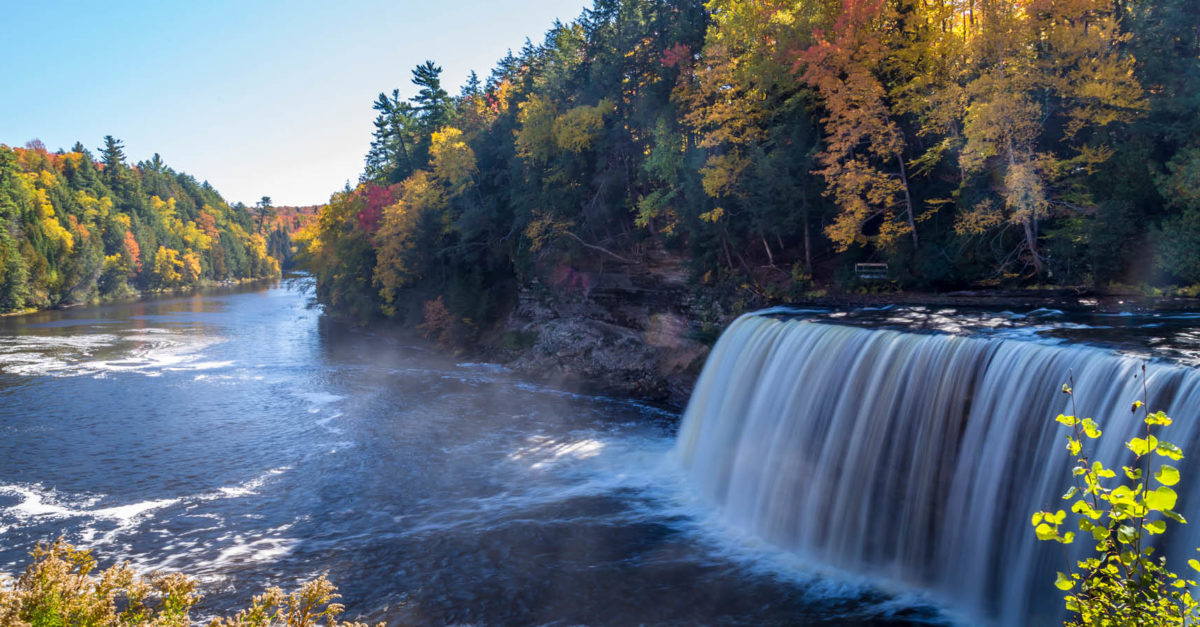A Superior Road Trip
Like Alice when she steps through the looking glass, when you cross the Mackinac Bridge and enter Michigan’s Upper Peninsula, you instantly land in an entirely different world.

Many Travelers Are Familiar
with Michigan’s Gold Coast, the state’s 300-mile western shoreline along Lake Michigan; however, those wanting more adventure, untamed wilderness, and eye-popping scenery will venture beyond the eclectic beach towns and head farther north to Michigan’s unspoiled Upper Peninsula, where it’s all about the journey.
A great jumping-off point is Mackinaw City, at the northern tip of Michigan’s Lower Peninsula and the southern end of the Mackinac Bridge. “Mighty Mac,” once the longest suspension bridge in the world and still the longest in the Western Hemisphere, is a majestic five-mile span over the Straits of Mackinac, which connects Lake Michigan and Lake Huron as well as the Upper and Lower Peninsulas. The “wow” factor starts here for a road trip you won’t forget.
Getting to the Point
Like Alice when she steps through the looking glass, when you cross the Mackinac Bridge and enter Michigan’s Upper Peninsula, you instantly land in an entirely different world. Billboards, city noise, and freeway traffic give way to wide skies, untrammeled forests, open roads, and, ultimately, the most unpredictable of the Great Lakes, Lake Superior, the largest freshwater lake in the world in terms of surface area. If drained, the lake would fill a swimming pool the size of the lower forty-eight states to a depth of nearly five feet, according to the National Park Service.
An easy 80-mile drive north from the bridge along the tree-lined, two-lane blacktop of Route 123 leads you to Whitefish Point, where you can enjoy a spectacular, wide-angle view of the lake. The Point is home to the Whitefish Point Light Station and is also part of a major migratory path for birds, waterfowl, and yellow swallowtail and monarch butterflies. In peak season, as many as 3,000 raptors may pass in a single day, making it one of the best birding spots in the Great Lakes region.
The Upper Peninsula is also home to some 150 waterfalls, the result of water running over the Au Train Formation, a shelf of hard, limey sandstone that geologically defines most of the U.P. Scores of falls are easy to get to, and each is different in terms of setting, drop, and flow. But the standouts are the Upper and Lower Falls at Tahquamenon Falls State Park, just 20 miles southwest of Whitefish Point. The Upper Falls, one of the largest cascades east of the Mississippi, has a drop of nearly 50 feet, reaches more than 200 feet across, and produces an impressive water flow of more than 50,000 gallons per second.

Continue west to visit Grand Marais, the eastern gateway to Pictured Rocks National Lakeshore. Less than two hours from Tahquamenon Falls, friendly lakeside Grand Marais boasts all things outdoorsy—fishing, kayaking and canoeing, swimming, camping, hiking, and more. Anglers cast their lines for whitefish and trout in the Harbor of Refuge in good weather and bad (though locals say the biting is better in bad weather). The tumbled-smooth Lake Superior stones that dot the Continue west to visit Grand Marais, the eastern gateway to Pictured Rocks National Lakeshore.
Less than two hours from Tahquamenon Falls, friendly lakeside Grand Marais boasts all things outdoorsy—fishing, kayaking and canoeing, swimming, camping, hiking, and more. Anglers cast their lines for whitefish and trout in the Harbor of Refuge in good weather and bad (though locals say the biting is better in bad weather). The tumbled-smooth Lake Superior stones that dot the spectacular must-see waterfall. A convenient shaded gravel path through the woods leads to two overlooks with views of the falls. The falls spill more than 40 feet over a sandstone ledge with a 10-foot crest.
Imagine the Grand Canyon with water; that colorful image only begins to approximate the majesty of nearby Pictured Rocks shoreline, a highlight of any trip to the U.P. The sheer rock walls that plunge into Lake Superior become a canvas for the natural mineral deposits that create their own form of abstract art. And, depending on the depth and the weather conditions, the water can change color—from turquoise to teal or emerald to tourmaline or a dark slate—as well as temperament, from placid to ferocious.
As every brochure and website will tell you, the best way to see the rocks is from Lake Superior. If you don’t have your own boat, kayak, or canoe, you can rent one. Better yet, you can take advantage of the popular Pictured Rocks Cruises, which, from mid-May through mid-October, introduce guests to miles of breathtaking, ever-evolving rock formations, caverns, and vast landscapes shaped by wind and water.
Back on shore, the Falling Rock Café and Bookstore awaits. Drop in for new and used books, as well as exhibits by local artists. You can also grab a bite at the lunch counter—smoked Lake Superior whitefish is a café specialty. Evenings are often given over to author events or live music.

Go West!
Your adventure takes you farther west along the southern edge of Lake Superior to Marquette. Home to Northern Michigan University and boasting a population of over 20,000—making it the largest city in the U.P.—Marquette has a youthful vibe and a lively, historic downtown at its center. This college town has its share of all things funky and fun, even a roller derby league—the Dead River Derby.
Not far from the NMU campus, art of all kinds awaits. For example, Presque Isle Antique Salvage and Decor mixes old and new deco, retro, and modern finds in a former Mobil service station. Several blocks away, Zero Degrees Artist Gallery features an eclectic array of contemporary ceramics, sculptures, paintings, jewelry, and metal by emerging and established artists.
Just down the block from Zero Degrees is Blackrocks Brewery, Marquette’s first microbrewery. Stop in to this small clapboard house to listen to “brewsicians” playing live music while you try some delicious craft beers. For a bite to eat, look no further than a pasty, a hearty, handheld meal in pastry dough that’s a regional staple. While in Marquette, try pasties from Jean Kay’s Pasties & Subs or Lawry’s Pasty Shop, both of which are only minutes from Blackrocks. To satisfy your sweet tooth, Jilbert Dairy, with its three oversized cow sculptures, is a refreshing stop when the craving hits for rich, local ice cream. You can then walk it all off at the city’s outdoor gathering spot, Mattson Lower Harbor Park, which comprises twenty-two acres of open space, bike paths, benches, picnic tables, a playground, and a boat ramp.
Back to the Mac
Enjoy the scenic three-hour drive back east by first hopping on the easily accessible Route 41 South in Marquette. Along the way, you’ll pass miles of tree-lined scenery before connecting with U.S. Highway 2; the northern shore of Lake Michigan now keeps you company along this route that was recently dubbed Top of the Lake Byway. Try to spot the Yooper and his cow (a much-loved U.P. roadside attraction) between Manistique and Gulliver. Be sure to grab lunch at the Naubinway’s Epoufette Bayview Inn, which features appetizing roadside favorites and an amazing view of Lake Michigan, and then take a short drive farther east to enjoy the scene from the cantilevered, steel-deck Cut River Bridge.
Take one last look around—your adventure, totaling about 450 miles, is nearly complete. Soon, Mighty Mac peeks over the horizon, providing one final, unforgettable view that encapsulates your “Superior” road trip to Michigan’s Upper Peninsula.
For more info, visit uptravel.com or michigan.org.






















